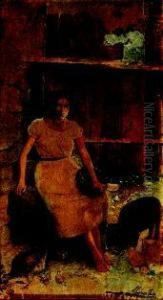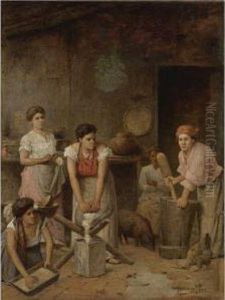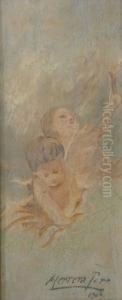Antonio Herrera Toro Paintings
Antonio Herrera Toro was a Venezuelan painter, teacher, and journalist, born on January 16, 1857, in Valencia, Carabobo, Venezuela. He began his artistic education under the guidance of Martín Tovar y Tovar, one of the most prominent Venezuelan artists of the 19th century. Herrera Toro's early work was influenced by Tovar y Tovar's academic style, which was characterized by a meticulous approach to painting and a keen interest in historical scenes and portraiture.
Herrera Toro's talent became evident early in his career, and he was sent to further his studies in Europe. He spent time in Italy, where he was exposed to the masterpieces of the Renaissance and the academic painting of the time. This experience enriched his technique and broadened his artistic perspective. Upon returning to Venezuela, he became an influential figure in the country's art scene, not only as a painter but also as an educator and advocate for the arts.
Throughout his career, Herrera Toro worked on various important projects, including the completion of the decoration of the National Pantheon in Caracas after the death of his mentor, Tovar y Tovar. His works include historical canvases, portraits, and religious pieces. As a portraitist, he captured the likenesses of many significant figures in Venezuelan society, as well as ordinary people, with a focus on realism and psychological insight.
In addition to his painting, Herrera Toro was actively involved in the cultural development of Venezuela. He played a significant role in the establishment of the Círculo de Bellas Artes, an important cultural institution in Caracas, and contributed to the promotion of young artists and the organization of art exhibitions. Furthermore, he served as a director of the Academy of Fine Arts in Caracas, where he influenced future generations of Venezuelan artists.
Herrera Toro's contribution to Venezuelan journalism was also notable; he founded and directed the magazine 'El Cojo Ilustrado', which became an important cultural and literary publication in Venezuela at the turn of the 20th century. This magazine not only showcased literary works but also served as a platform for the dissemination of artistic knowledge and the promotion of the visual arts.
Antonio Herrera Toro passed away on November 21, 1914, in Caracas. His legacy as a painter, teacher, and cultural promoter has left a lasting impact on the Venezuelan art world. His works are preserved in various collections and continue to be studied and admired for their historical significance and artistic quality.


